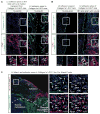Infarct Fibroblasts Do Not Derive From Bone Marrow Lineages
- PMID: 29269349
- PMCID: PMC5815911
- DOI: 10.1161/CIRCRESAHA.117.311490
Infarct Fibroblasts Do Not Derive From Bone Marrow Lineages
Abstract
Rationale: Myocardial infarction is a major cause of adult mortality worldwide. The origin(s) of cardiac fibroblasts that constitute the postinfarct scar remain controversial, in particular the potential contribution of bone marrow lineages to activated fibroblasts within the scar.
Objective: The aim of this study was to establish the origin(s) of infarct fibroblasts using lineage tracing and bone marrow transplants and a robust marker for cardiac fibroblasts, the Collagen1a1-green fluorescent protein reporter.
Methods and results: Using genetic lineage tracing or bone marrow transplant, we found no evidence for collagen-producing fibroblasts derived from hematopoietic or bone marrow lineages in hearts subjected to permanent left anterior descending coronary artery ligation. In fact, fibroblasts within the infarcted area were largely of epicardial origin. Intriguingly, collagen-producing fibrocytes from hematopoietic lineages were observed attached to the epicardial surface of infarcted and sham-operated hearts in which a suture was placed around the left anterior descending coronary artery.
Conclusions: In this controversial field, our study demonstrated that the vast majority of infarct fibroblasts were of epicardial origin and not derived from bone marrow lineages, endothelial-to-mesenchymal transition, or blood. We also noted the presence of collagen-producing fibrocytes on the epicardial surface that resulted at least in part from the surgical procedure.
Keywords: bone marrow; fibroblasts; fibrosis; heart diseases; myocardial infarction.
© 2017 American Heart Association, Inc.
Figures




Comment in
-
The Cellular Origin of Activated Fibroblasts in the Infarcted and Remodeling Myocardium.Circ Res. 2018 Feb 16;122(4):540-542. doi: 10.1161/CIRCRESAHA.118.312654. Circ Res. 2018. PMID: 29449358 Free PMC article. No abstract available.
References
-
- Camelliti P, Borg TK, Kohl P. Structural and functional characterisation of cardiac fibroblasts. Cardiovascular research. 2005;65:40–51. - PubMed
-
- Moore-Morris T, Guimaraes-Camboa N, Banerjee I, Zambon AC, Kisseleva T, Velayoudon A, Stallcup WB, Gu Y, Dalton ND, Cedenilla M, Gomez-Amaro R, Zhou B, Brenner DA, Peterson KL, Chen J, Evans SM. Resident fibroblast lineages mediate pressure overload-induced cardiac fibrosis. The Journal of clinical investigation. 2014;124:2921–2934. - PMC - PubMed
-
- Ali SR, Ranjbarvaziri S, Talkhabi M, Zhao P, Subat A, Hojjat A, Kamran P, Muller AM, Volz KS, Tang Z, Red-Horse K, Ardehali R. Developmental heterogeneity of cardiac fibroblasts does not predict pathological proliferation and activation. Circulation research. 2014 - PubMed
-
- Sun Y, Weber KT. Infarct scar: A dynamic tissue. Cardiovascular research. 2000;46:250–256. - PubMed
-
- Zhou B, Honor LB, He H, Ma Q, Oh JH, Butterfield C, Lin RZ, Melero-Martin JM, Dolmatova E, Duffy HS, Gise A, Zhou P, Hu YW, Wang G, Zhang B, Wang L, Hall JL, Moses MA, McGowan FX, Pu WT. Adult mouse epicardium modulates myocardial injury by secreting paracrine factors. The Journal of clinical investigation. 2011;121:1894–1904. - PMC - PubMed
Publication types
MeSH terms
Substances
Grants and funding
LinkOut - more resources
Full Text Sources
Other Literature Sources
Medical

